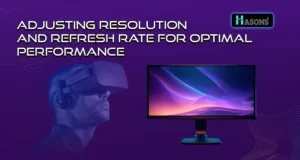Enhancing Productivity with Computer Screens Optimization
In our digital age, where the lines between work and life often blur, optimizing your Computer Screens can be a game-changer for your productivity. Whether you’re a student, a professional, or someone who spends a considerable amount of time in front of a computer, understanding how to make the most of your screen can significantly impact your efficiency and overall well-being.
Introduction:
Imagine being able to navigate through your tasks seamlessly, with minimal distractions and eye strain. Visualize a workspace where everything is within reach, and your computer screens is an extension of your focus and creativity. This is the power of computer screens optimization, and it’s a skill that can elevate your productivity to new heights.
Understanding the Role of Screens Display Settings
The first step to optimizing your computer screens is to familiarize yourself with the display settings. These settings are the foundation upon which your entire visual experience is built, and they can have a profound impact on your productivity.
Adjusting Resolution and Refresh Rate for Optimal Performance
Resolution and refresh rate are two crucial factors that can significantly influence your visual experience. The resolution determines the level of detail and clarity displayed on your screen, while the refresh rate dictates how smoothly images and animations are rendered.

For optimal performance, it’s essential to strike a balance between these two settings. A higher resolution allows for more on-screen real estate, making it easier to multitask and work with larger windows. However, if the resolution is set too high, it can strain your eyes and potentially slow down your computer’s performance.
On the other hand, a higher refresh rate can reduce eye strain and improve the overall smoothness of motion, making it ideal for tasks that involve frequent scrolling or animation. However, setting the refresh rate too high can also have a negative impact on your computer’s performance.
To find the sweet spot, experiment with different resolution and refresh rate combinations until you find the one that works best for your needs. Remember, the ideal settings may vary depending on the size of your screen and the specific tasks you perform.
Managing Brightness and Contrast Settings for Eye Comfort
While resolution and refresh rate are important for performance, brightness and contrast settings play a crucial role in ensuring eye comfort during prolonged computer use. Excessive brightness or contrast can lead to eye strain, headaches, and fatigue, ultimately hindering your productivity.
To combat this, adjust your screen’s brightness to a level that’s comfortable for your eyes. A general rule of thumb is to match the brightness of your screen to the ambient lighting in your workspace. Additionally, adjusting the contrast can help improve the visibility of on-screen content, making it easier to distinguish between different elements.
Many modern operating systems also offer features such as Night Light or Night Shift, which can reduce the amount of blue light emitted by your screen. Blue light has been linked to disruptions in sleep patterns and eye strain, so enabling these features, especially during evening hours, can be beneficial for your overall well-being.
Organizing Your Workspace: Screens Arrangement and Multitasking
Once you’ve mastered the display settings, it’s time to focus on organizing your workspace. A well-organized workspace can significantly boost your productivity by minimizing distractions and facilitating efficient multitasking.
Utilizing Multiple Monitors Effectively
One of the most powerful tools for enhancing productivity is the use of multiple monitors. With additional screen real estate, you can have multiple applications or windows open simultaneously, reducing the need for constant alt-tabbing or window switching.
When setting up multiple monitors, it’s important to consider their placement and orientation. Ideally, your primaryz monitor should be directly in front of you, while secondary monitors should be positioned to the left or right, mimicking your natural field of vision.
Additionally, you can take advantage of features like window snapping or split-screen modes to automatically position windows across multiple monitors. This can help you create dedicated workspaces for different tasks, improving your focus and reducing the risk of distractions.
Maximizing Screens Real Estate with Window Management Tools
Even with a single monitor, you can still maximize your screen real estate and improve your productivity by utilizing window management tools. These tools allow you to easily resize, position, and organize windows, enabling you to work more efficiently.
Exploring Window Snapping and Split View Features
Most modern operating systems come equipped with built-in window management features, such as window snapping and split view. Window snapping allows you to quickly resize and position windows by dragging them to the edges or corners of your screen, while split view enables you to view two windows side by side, each occupying half of the screen.
These features are particularly useful when working with multiple applications or documents simultaneously. For example, you can snap a web browser to one side of the screen while keeping a word processor or spreadsheet open on the other side, allowing you to reference information seamlessly.
Customizing Window Sizes and Positions for Seamless Navigation
While built-in window management tools are convenient, many users find that third-party applications offer even more flexibility and customization options. Tools like Magnet, Spectacle, or WindowGrid can help you precisely resize and position windows with keyboard shortcuts or customizable hotkeys.
With these tools, you can create custom window layouts that suit your specific workflow, ensuring that every pixel of your screen is utilized efficiently. Whether you prefer a tiled layout for multitasking or a more freeform approach, these applications offer the flexibility to tailor your workspace to your unique needs.
Ergonomic Considerations: Screens Positioning and Viewing Distance
While optimizing your screen’s settings and organizing your workspace can significantly enhance your productivity, it’s equally important to consider ergonomic factors. Poor screen positioning and improper viewing distances can lead to physical discomfort, eye strain, and long-term health issues, all of which can ultimately impact your productivity.
To ensure a comfortable and healthy computing experience, position your screen at a distance that allows you to view it without straining your eyes or neck. The ideal viewing distance is typically between 20 and 26 inches from your eyes, but this may vary depending on the size of your screen and your personal preferences.
Additionally, adjust the height of your screen so that the top of the display is at or slightly below eye level. This can help reduce neck strain and promote better posture. If necessary, use a monitor stand or adjust the height of your desk or chair to achieve the optimal screen position.

Troubleshooting Common Screens Issues and Solutions
Even with the best optimization efforts, you may occasionally encounter screen issues that can disrupt your productivity. It’s important to be prepared and know how to troubleshoot these issues effectively.
Dealing with Screens Flickering and Display Artifacts
One of the most common screen issues is flickering or display artifacts. These visual distortions can be caused by various factors, including outdated or conflicting drivers, hardware issues, or compatibility problems with your graphics card or monitor.
If you encounter these issues, the first step should be to update your graphics drivers to the latest version. Outdated drivers can often lead to compatibility issues and visual glitches. Additionally, you should try adjust your monitor refresh rate or resolution setting to see if the issue is resolve.
If the problem persists, it may be worth checking your monitor’s connections and cables. Loose or damaged cables can cause intermittent flickering or display artifacts.
Future Trends in Computer Screens Technology
As technology continues to evolve, the future of computer screens promises even more exciting advancements that can further enhance our productivity and overall computing experience.
Embracing High-Resolution Displays and HDR Technology
One of the most anticipated trends in computer screens technology is the widespread adoption of high-resolution displays and HDR (High Dynamic Range) technology. These advancements offer stunning visuals with incredible detail and vibrant colors, making them ideal for creative professionals, designers, and anyone who demands exceptional image quality.
High-resolution displays, such as 4K or even 8K resolutions, provide incredibly sharp and detailed visuals, allowing you to view intricate details in your work with unprecedented clarity. This can be particularly beneficial for tasks like photo editing, video production, or working with detailed diagrams and schematics.
HDR technology, on the other hand, offers a wider range of colors and improved contrast, resulting in more lifelike and vibrant visuals. This can be especially useful for creative professionals working with color-critical tasks, as well as for anyone who wants to enjoy an immersive visual experience while watching movies or playing games.
As these technologies become more accessible and affordable, they will undoubtedly revolutionize the way we interact with our computers, offering a more immersive and visually stunning experience that can further enhance our productivity also creativity.
| If you are reading Computer Screens then also check our other blogs: | |
| Computer Virus | First Electronic Computer |
Computer Screens
In conclusion, optimizing your computer screen is a crucial step toward unlocking your productivity potential. By mastering display settings, organizing your workspace, and embracing ergonomic considerations, you can create a visual environment that fosters focus, efficiency, and overall well-being. As technology continues to advance, the future of computer screens promises even more exciting innovations that will further enhance our digital experiences. Embrace the power of your computer screen, and watch your productivity soar to new heights.
